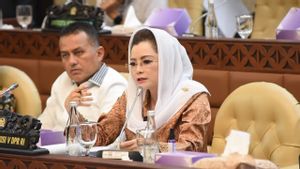JAKARTA In the midst of global economic stagnation, various strategic policies of the Government have succeeded in supporting the resilience of the national economy.
As of March 2024, the poverty rate continued its downward trend to 9.03 percent from 9.36 percent in March 2023.
In addition, the poor population in March 2024 decreased by 0.68 million people from March 2023 so that the number of poor people became 25.22 million people.
This poverty rate is the lowest in a decade.
Spatially there has been an improvement, the poverty rate has decreased both in urban and rural areas. The poverty rate in urban areas fell to the level of 7.09 percent from 7.29 percent in March 2023.
Meanwhile, the percentage of poor people in rural areas decreased to 11.79 percent from 12.22 percent in March 2023.
Poverty reduction also occurred throughout Indonesia, with the highest decline occurring in Bali and Nusra.
Meanwhile, the level of inequality in Indonesia's population expenditure (Rasio Gini) also decreased and was below the pre-pandemic level to 0.379 in March 2024 compared to 0.388 in March 2023.
That level is the lowest in a decade.
The decrease in inequality occurred both in urban and rural areas.
Head of the Fiscal Policy Agency of the Ministry of Finance, Febrio Kacaribu, said that the reduction in poverty in March 2024 was supported by the solid domestic economic activity and various government social assistance programs, especially in responding to the increase in food inflation in early 2024.
According to Febrio, this reduction in poverty provides hope amid the stagnation of the global economy.
"The government will continue to be committed to maintaining inflation stability so that it can encourage an increase in people's purchasing power, which can further accelerate the reduction in poverty and improve people's welfare", said Febrio in his statement, Tuesday, July 2.
In line with that, inflation in June 2024 was recorded at 2.51 percent (yoy), a significant decrease compared to May 2024 of 2.84 percent, supported by controlled food prices and stable core inflation.
In the month to month, there was a deflation of 0.08 percent along with several food prices that continued to slope.
Febrio said that volatile food inflation shows a sloping trend.
Various food prices continue to decline, such as shallots, tomatoes, meat and broiler eggs, fresh fish, and several types of vegetables.
"This trend is in line with the increase in stocks supported by domestic supply and adequate distribution," he said.
Febrio said rice prices also continue to show a positive trend, supported by supply stabilization and food prices (SPHP) programs and strong food reserves.
This prompted volatile food inflation in June to continue to slow down to 5.96 percent (yoy), from 8.14 percent (yoy) in May 2024.
Febrio said that core inflation and administrative prices support the control of general inflation in the target range. Therefore, core inflation only experienced a slight decline of 1.90 percent (yoy) from 1.93 percent (yoy) in May 2024.
He said that the condition of core inflation still shows strong people's purchasing power even though they still have to be wary of.
Meanwhile, administrative price inflation increased slightly, to 1.68 percent (yoy), from 1.52 percent (yoy) in May 2024, influenced by seasonal factors, namely increasing air transportation rates in the middle of the school holiday season and dynamics in avtur prices.
"controlled inflation is also inseparable from strong monetary fiscal coordination through the central inflation control team (TPIP) and the regional inflation control team (TPID)," he said.
Although the trend of inflation has shown a decline in recent months, he continued, the government continues to prepare by strengthening policies that anticipatoryly maintain domestic production amid climate change risks and disaster preparation.
In addition, Febrio said, the government will continue to increase synergy and coordination with the relevant Ministries of Institutions, both at the central and regional levels, to create the right policy mix in responding to the situation.
Indonesian manufacturing activities also continue an expansive trend for 34 consecutive months as of June 2024.
The Indonesian Manufacturing Purchasing Managers' Index (PMI) is at the level of 50.7 compared to May 2024 of 52.1.
"Manufacturing performance is driven by expansionary output and demand levels," he explained.
Several Indonesian trading partner countries also recorded expansive manufacturing activities, including China and the United States, respectively at the levels 51.8 and 51.7.
SEE ALSO:
PMI manufacturing countries in the ASEAN region such as Vietnam and Thailand are also expansive, respectively at levels 54.7 and 51.7.
On the other hand, the manufacturing activities of the European region are still in the contraction zone at the level of 45.6. Countries in the European region such as Germany and France have contracted to levels 43.4 and 45.3, respectively.
"In the midst of global economic stagnation and financial market turmoil, PMI Indonesia is still in an expansive trend and we hope that this trend will continue into the following months with better quality. The government seeks various policy supports to encourage growth and maintain national economic stability in the future," closed Febrio.
The English, Chinese, Japanese, Arabic, and French versions are automatically generated by the AI. So there may still be inaccuracies in translating, please always see Indonesian as our main language. (system supported by DigitalSiber.id)













